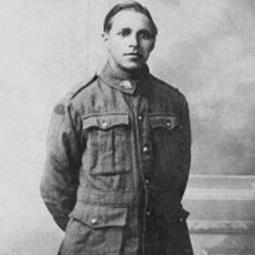LOVETT, Leonard Charles
| Service Number: | 1336 |
|---|---|
| Enlisted: | Not yet discovered |
| Last Rank: | Private |
| Last Unit: | 39th Infantry Battalion |
| Born: | Not yet discovered |
| Home Town: | Not yet discovered |
| Schooling: | Not yet discovered |
| Occupation: | Not yet discovered |
| Memorials: | Heywood St. Mary's Mission Church Great War Roll of Honour |
World War 1 Service
| 27 May 1916: | Involvement Private, 1336, 39th Infantry Battalion, --- :embarkation_roll: roll_number: '18' embarkation_place: Melbourne embarkation_ship: HMAT Ascanius embarkation_ship_number: A11 public_note: '' | |
|---|---|---|
| 27 May 1916: | Embarked Private, 1336, 39th Infantry Battalion, HMAT Ascanius, Melbourne |
Leonard Charles Lovett
The Lovett brothers
The brave men of the Gunditjmara garrison
First family group to be inducted to the Victorian Indigenous Honour Roll
The Lovett brothers occupy a special place in the history, not just of Australia, but also of the Commonwealth. Four of the brothers served in both World War One (WWI) and World War Two (WWII). Their unique family story has come to symbolise the contribution that thousands of Aboriginal men and women have made to the defence of Australia, even at a time when citizenship rights were denied to them at home.
Alfred, Leonard, Frederick, Edward and Herbert were the sons of James Lovett, an Aboriginal man from South Australia, and Hannah (née McDonald), a descendant of the Kerrup-Jmara clan of the Gunditjmara nation in Western Victoria. As a child, Hannah, her mother, and her brother, were among the first Aboriginal people at Lake Condah Mission after it was established in 1862. Hannah went on to have 13 children, among them five boys who would enlist to fight in WWI.
Against the odds, all five brothers returned home safely. Although the Great War had been an equaliser of men — racism had no place in the trenches — little had changed in civilian life. After the closure of Lake Condah Mission in 1919 the Lovett family made a living in the surrounding district.
Four of the five original brothers re-enlisted during WWII, however due to their age they served within Australia. Their younger brother, Samuel, and several other family members also served in Australia and overseas. All returned unharmed, as has every member of the Lovett family who has served in the Australian Armed Forces — 21 men and women in total.
As a result of the heroic service of the Lovett brothers and their post-war activism in support of the service of Indigenous soldiers, Aboriginal service men and women today are given the support and recognition they deserve.
Nigel Steel, a historian at the Imperial War Museum in London, once stated that he knew of no other record of military service by a single family that matched that of the Lovett family. Fittingly, the building that contains the Department of Veteran's Affairs in Canberra was renamed Lovett Tower in honour of their distinguished military contribution.
The Lovett brothers were descended from a long line of heroic warriors; the 'Fighting Gunditjmara' people who saw conflict from the earliest days of European settlement. While there is pain in these stories, they also offer lessons for us all: in courage, resilience and hope.
Leonard Charles Lovett
1884-1951
Leonard, commonly known as Charlie, enlisted on 27 May 1916 and served as a Private in the 39th Battalion of the 3rd Division. He fought on the Western Front, including significant campaigns at Passchendaele in 1917 and Amiens in 1918. He returned to Australia in 1919 and was awarded two service medals.
Many people were surprised to discover that Leonard spoke fluent German. It is thought that he picked up the language while working around Tarrington, near Hamilton, which was settled by German-speaking pioneers.
Among his occupations, Leonard worked as a drover. He married Elsie Maude Clark, with whom he had seven children. Leonard re-enlisted during WWII. Between 1941–42, he was stationed in Australia as a Private with the 3rd Garrison Battalion. His daughter, Alice, served with the Women's Auxiliary Australian Air Force in WWII and his son, also named Leonard Charles, served in the Korean War. Hiis grandson, Mervyn, served in the Vietnam War.
Leonard passed away in 1951 at the age of 67.
Submitted 27 May 2019 by Evan Evans










